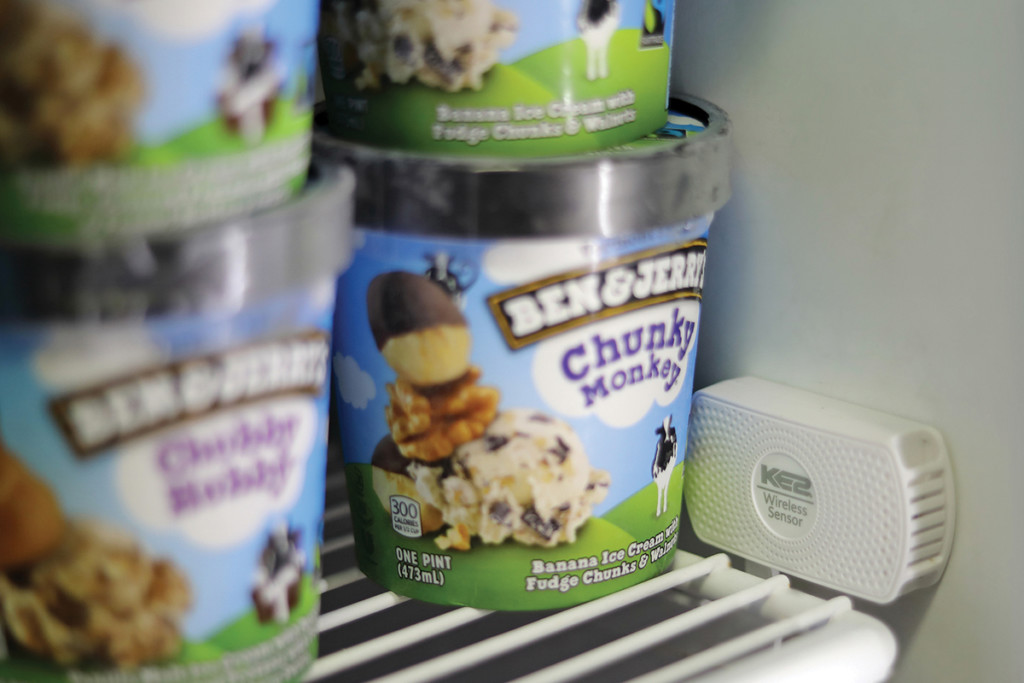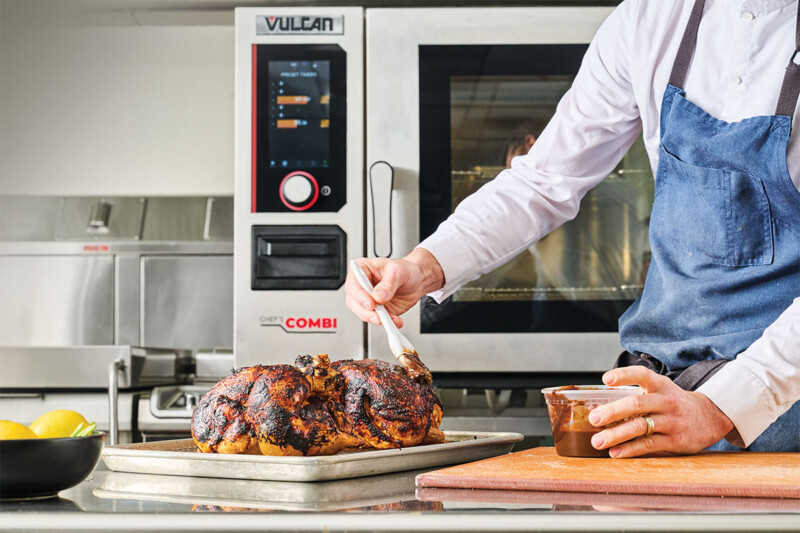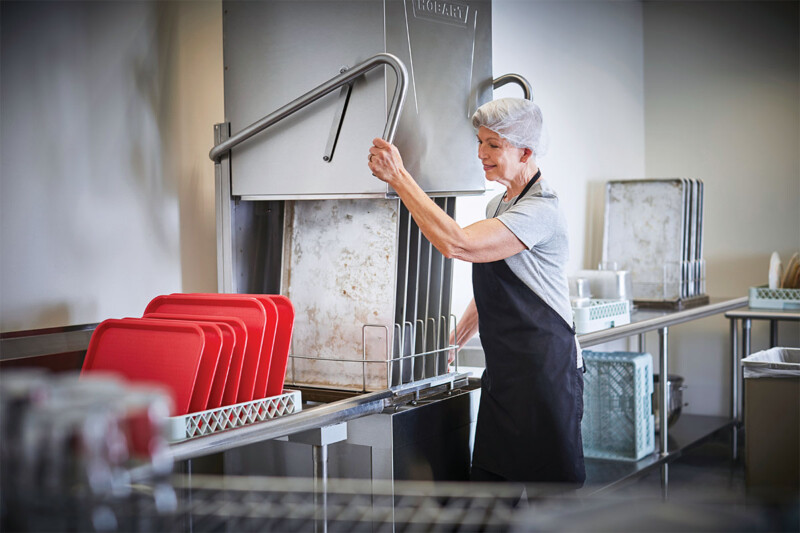
We’ve read enough in the news recently about food safety failures at several major chains; it should give everyone pause that even the most well-established enterprises are at risk when systems aren’t in place.
Your managers set an alarm when they lock up at night to ward off burglars who might steal your cash or equipment, or vandalize your operation. But other thieves—improper food temperatures, primarily—will happily rob your business, and they don’t have to break and enter to do it. Fortunately, when it comes to safe temperature control, kitchen monitors can protect you from these risks as well.
Why kitchen monitors? First off, monitors can help ensure food safety, mitigating a foodborne illness that could cause you the loss of reputation, customers and sales. The most common monitors in a kitchen are the thermometers your staff use to make sure foods being stored, prepped, cooked and cooled or served are at the right, safe temperatures. Monitors, such as temperature alarms on walk-ins, maintain a constant vigil, keeping your customers safe.
Second, monitors also help protect your investment. If you have to throw out all the food in your walk-in refrigerator or freezer because of a power outage or compressor failure, you’re losing a lot of money. A temperature monitor can prevent that. Likewise, a walk-in door that’s left open all the time will cost you money in energy and increased maintenance to service an over-worked compressor. A simple door alarm can solve the problem.
Finally, monitors save you labor. Like your burglar alarm, monitors keep an eye on things 24/7, and, depending on the task, can alert the right people to take corrective action if needed, and will document that action. And, if you depend on a HACCP plan to keep your local health department out of your kitchen as much as possible, monitoring systems can track and record all the data for you. Look, ma, no humans.
Sensor Selection
Choose your monitors and/or monitoring system based on your priorities. Adhering to a HACCP plan and making it easier and more foolproof is one goal. Preventing the loss of inventory is another, as is saving energy or deterring employee theft. One type of monitor or monitoring system may help you achieve all those goals, but you may have other goals as well.
A leading chain’s fast-food franchisee in New York, for example, wanted a better way to monitor and manage four areas in his 12 stores—food spoilage, water on walk-in and electrical closet floors, walk-in doors, and the cash safe in each unit. Wireless sensors monitor these areas continuously, so managers don’t have to, and send alerts via text and email through an online dashboard.
Knowing what you can monitor also may affect your priorities and goals. The following is a list of what you can measure with systems available today. Recognize, however, that not all of these types are available from all makers.
Temperature. Most temperature sensors measure in the range in which cold food storage and hot food holding falls, so you can use them for either. They’re available with both thermocouple and thermistor probes, both of which are fine in most applications, though thermocouples tend to be somewhat more rugged. You can get special sensors for higher temperatures, for monitoring cooking/holding equipment such as ovens and hot boxes, for example, or waterproof sensors for monitoring dishmachine rinse temperature (180°F). You can get some sensors with dual probes to measure two separate areas at once, like the prepared foods and raw protein sections of a walk-in.
Buffered temperature. This type of temperature sensor is typically encased in a tube of glycol, making the probes less susceptible to shifts in temperature, like the one in your walk-in when you get a delivery of refrigerated or frozen foods. Or the one in your reach-in during a rush. Many regular temperature sensors, however, let you set a time delay to account for this type of refrigeration usage or incident.
Humidity. You may want sensors that measure relative humidity to keep an eye on both dry and cold storage areas, especially those where you store food sensitive to moisture, such as flour or produce. A number of manufacturers make combined temp and humidity sensors, too.
Moisture. These sensors detect the presence—or absence—of water, protecting your property from water leaks and/or flooding.
Motion. These sensors detect different types of movement. One senses motion in a room or area, such as that of someone entering, usually by sound. These often are used for turning on lights or signaling an intruder. Another sensor detects vibration, typically used to monitor rotating equipment and machines. Accelerometers can measure tilt and impact, useful in making sure “This End Up” means what it says.
Magnetic/electrical. Sensors that detect a break in electrical current notice when doors, such as your front door or that on your walk-in, are open or closed. Voltage meters detect current or lack of it, letting you know when power is out or your operation has experienced a power surge, potentially damaging some of your equipment.
Air qualty. Gas sensors can measure carbon monoxide levels (which you may already have on your security system) and other gases such as ammonia, benzene and methane.
Data loggers. These sensors have added memory so they can record data over long periods of time, typically used to track product shipments on trucks. In foodservice, you can use them to monitor temperatures, humidity, or even the position of hot or cold boxes being transported from one facility to another or used for catering. Depending on the make and model, you may be able to download data from these devices wirelessly or with a USB cable or thumb drive.
Simple, Or System?
Once you prioritize your goals for kitchen monitors, you can decide how simple or complex your monitors need to be.
Standalone sensors represent the simplest form of monitoring. These will signal you with an audible and/or visual alarm when conditions aren’t right—temperature in a walk-in too high; a walk-in or storeroom door open too long; or the presence of carbon monoxide, for example. Unfortunately, that won’t help you in the middle of the night when no one’s around.
More sophisticated are wireless sensors that can feed, via their own Wi-Fi router, to your computer or cloud account and send you alerts by email, text or phone call to let you know something’s wrong. They give you the ability to take corrective action when something’s not within the parameters you set. That may be all you need to protect your customers and your investment in food and energy. And even wireless sensors should have easy-to-read LCD screens and onboard audio and visual alerts to let you know when conditions don’t meet parameters or power is low, for example. If you’re monitoring several different areas of your operation, however, or if you need to track data as back-up for your HACCP plan, you’ll need a system that includes data loggers or a way to transmit data on a regular basis to either your computer or a cloud server. That typically means a more complex or sophisticated system. Depending on the system and company you choose, however, installing and operating it may be relatively simple.
The Right Wireless
There are a few ways wireless sensors can transmit data to a central location, be it a computer or cloud server. All use radio frequency (RF), but there are different types. A kitchen usually has a lot of metal and walls, sometimes making it difficult to transmit and receive data via RF. Fortunately, there are options and workarounds.
Wi-Fi. Typically, sensors transmit data wirelessly via Wi-Fi (a trademark term for specific radio frequency bandwidths— 2.4 and 5.8 GHz—and IEEE protocol). Range of these devices is about 66 ft., and they work best in line-of-sight. To accommodate better transmissions in kitchens, for example, walk-in sensors connect a temperature probe inside the walk-in with a wire to the Wi-Fi transmitter on the outside of the door.
One manufacturer says its proprietary Wi-Fi bandwidth is robust enough to transmit through metal walk-in doors, so drilling holes for the hard-wired probe isn’t necessary. Other makers use repeaters to boost signal strength where walls or metal get in the way, again eliminating the need for hard-wired probes.
Bluetooth. Another IEEE-standardized RF technology uses ultra-high frequencies between 2.4 and 2.485 GHz to transmit data over short distances. Originally intended to replace RS-232 data cables (remember those?), Bluetooth now can connect a range of devices to each other, such as a sensor to a Wi-Fi transmitter.
Cellular. Some sensing devices use 3G cellular bandwidth to connect directly to a cloud server, though it’s more common in systems using cellular service for the devices to connect to a bridge or data gateway via Wi-Fi, which in turn transmits data to the cloud via 3G.
Bridging the connection. Most systems use some kind of bridge or gateway connection between wireless sensors, and either your computer, a cloud server, or an Ethernet connection to a central computer. This device, similar to a router, uses Wi-Fi or, as noted above, cellular to connect to whichever of those central repositories you choose. Most systems allow you to connect up to about 20 wireless sensors to the gateway.
Power To The Pieces
Wireless sensors operate with batteries so they’re as portable as possible and can be moved around your kitchen. Most use AA or AAA lithium batteries, but some use button cell batteries. Batteries typically last about 10 months to a year before needing a charge or replacement, depending on how often they transmit data. Most systems let you set the interval, usually between five and 10 minutes. Rechargeable batteries last around four or five years before they need to be replaced.
Repeaters to boost signals and gateways or bridges are powered by standard 110-120V current, but both usually have battery back-up, and gateways may have a memory buffer to hold data that comes in from sensors (instead or in combination) until power is restored and they become operable again. In some systems, the sensors themselves have a memory buffer and continue to store data until they’re able to communicate with the gateway.
No matter how the system is configured, all will send alerts to a pre-selected list of contacts in the event of a power outage, so you have an opportunity to take corrective action before food is compromised. Also, you can set up most systems/sensors with a time delay so they send an alert only after some time has elapsed—10 or 15 minutes, for example—after parameters are exceeded so you don’t get a lot of false alerts.
Battery-operated devices also have onboard “low battery” alerts that will let you know when it’s time to recharge or replace batteries. These alerts also may show up on your system dashboard, depending on the manufacturer.
The Softer Side
Running someone else’s software on your in-house system may be less than ideal, and sometimes means you have to conform to the software and system. With cloud-based systems, you still use a supplier’s software, but it resides on its servers, not on your computers. Most provide an easy-to-use dashboard that you can access on a smartphone, tablet or computer.
Dashboards quickly steer you to the information you want and provide alerts and notifications up front. You can customize reports, in most cases. Some will export data to Excel, others may format in PDF. You’ll have to decide if the format allows you to view and manipulate the data the way you want.
Cost of these systems varies, with price per device or data point in the range of $75 to $250. Cost of a gateway or networking device is around $450 to $500, so a typical monitoring system with five sensors and a gateway is usually less than $1,000, a fraction of the cost of the food in your walk-in.
Monitoring and cloud data storage cost in the range of $20 to $25 per month, though one manufacturer offers free cloud service.
Sensor System Sense
Prioritize the areas you want to monitor by what’s required, such as HACCP data recording, what can prevent the biggest loss to your operation (food lost to a power outage or a foodborne illness, as examples), and what can save you the most money (e.g., food and energy loss).
Select a supplier with foodservice experience. There are dozens of companies that make monitoring devices and systems, but many are designed for the medical or pharmaceutical fields. They’ll work, but you want a supplier who understands your business.
Pick a system that is scalable, one that you can easily add sensors to, both in terms of numbers and types. Regular Wi-Fi-based systems usually will easily recognize another device, but not always, and particularly not if the manufacturer is using a proprietary wireless protocol or bandwidth.
Find out if devices made by another manufacturer can connect to the system you’d prefer to buy. You may want to start out monitoring walk-in temperatures and doors, but are considering adding wireless hand-held temperature probes later that aren’t available from the same maker.
Don't use your guest-services Wi-Fi network or the network you use for your back-office software to run your monitoring systems. Systems and devices should be on a separate, password-protected Wi-Fi network dedicated to monitoring so no one can compromise your food safety system or any of your linked kitchen equipment.
Choose a system that offers the type of alerts you want to receive. Most send alerts via SMS text, email and/or phone, but double-check. Find out how many people can be included on alerts.
If you use a cloud-based monitoring service, find out if you can limit the number of people who have access to the cloud account and how many you can give administrative responsibility to (to manipulate data, reports formats, etc.) as well as how you can limit administrative access to your account.
Some systems are out-of-the-box plug-and-play; others will require some installation (such as those with hard-wired probes). Be sure the manufacturer and/or dealer/distributor can handle installation if necessary, and can troubleshoot even plug-and-play systems.
As always, check warranty periods and service networks.
Click to the next page for the Temperature Monitoring Product Gallery.
RELATED CONTENT
- Advertisement -
- Advertisement -
- Advertisement -
TRENDING NOW
- Advertisement -
- Advertisement -
- Advertisement -


